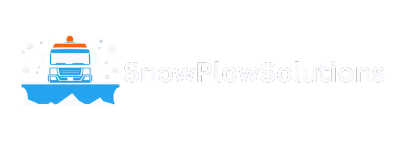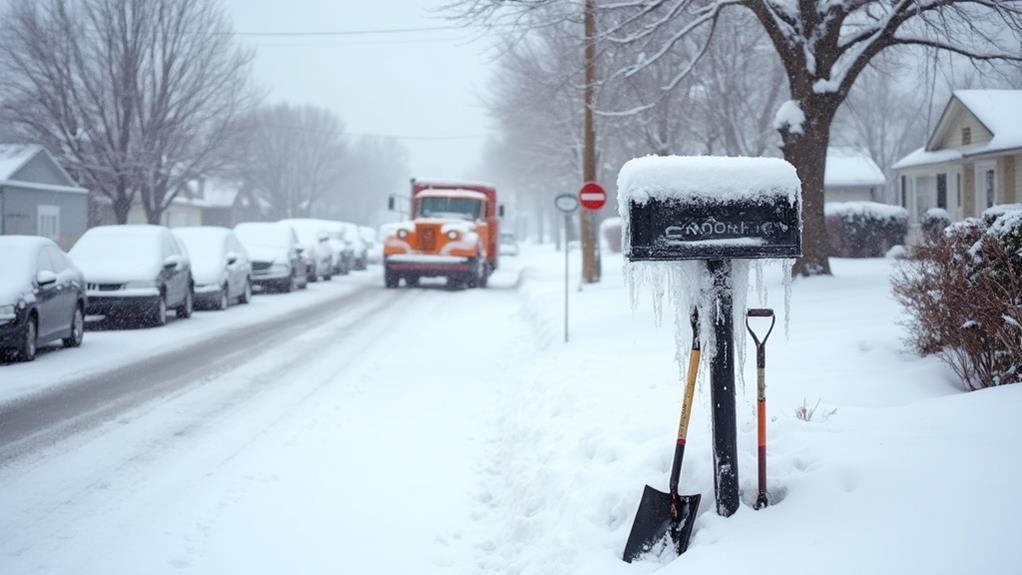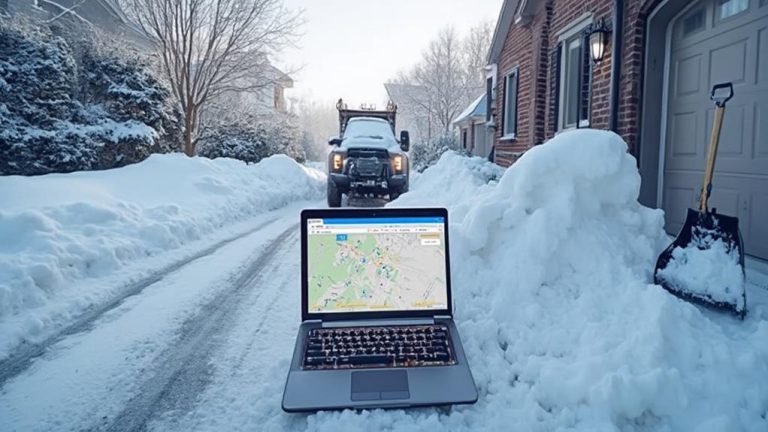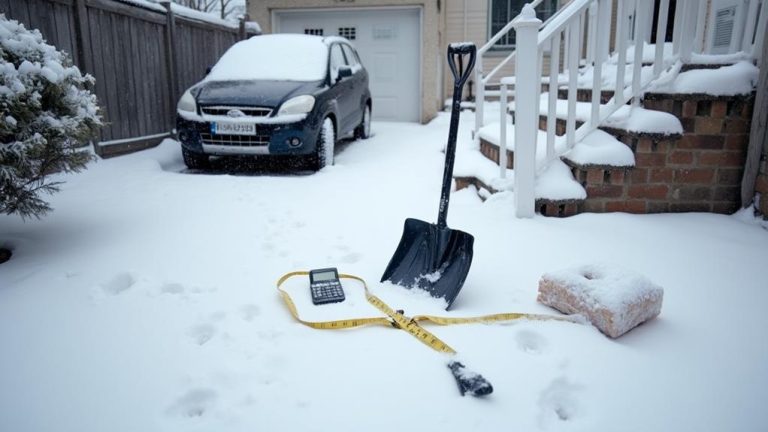Snow removal regulations are municipal codes designed to guarantee public safety and accessibility during winter weather events. You'll typically find requirements for property owners to clear adjacent sidewalks within a specified timeframe, maintain a minimum cleared path width, and avoid depositing snow onto public streets or neighboring properties. These ordinances often include rules about clearing around fire hydrants and storm drains, as well as guidelines for using de-icing agents. Enforcement can involve patrols, warnings, and fines for non-compliance. By adhering to these regulations, you're contributing to a safer community and reducing liability risks. Exploring local ordinances can provide more specific insights into your area's requirements.
Snow Plowing Highlights
- Property owners are typically required to clear snow from adjacent sidewalks within a specified timeframe.
- Snow removal ordinances often specify minimum widths for cleared paths to ensure pedestrian safety.
- Depositing snow onto public streets or neighboring properties is generally prohibited by local regulations.
- Penalties for non-compliance may include warnings, fines, and potential property liens.
- Regulations aim to maintain public safety, accessibility, and emergency vehicle access during winter weather events.
Definition of Snow Removal Ordinances

Snow Plow Solutions offers exhaustive services to help customers navigate and comply with local snow removal ordinances. Our team of experts stays up-to-date on municipal regulations, ensuring that property owners and businesses meet their legal obligations for snow and ice removal.
We provide timely alerts about upcoming storms, offer customized snow removal plans tailored to specific property needs, and execute efficient clearing services that adhere to local guidelines. By using heavy-duty equipment designed for efficient snow removal, we execute our tasks rapidly and completely.
Purpose of Snow Ordinances
Guaranteeing public safety and maintaining accessibility are the primary goals of snow removal ordinances. These regulations are designed to keep our community functioning smoothly during winter weather events, allowing residents to go about their daily lives with minimal disruption. By establishing clear guidelines for snow removal, we're working together to create safer streets, sidewalks, and public spaces for everyone.
Snow ordinances serve multiple purposes beyond just clearing roads. They help prevent accidents by reducing slippery conditions, safeguard emergency vehicles can reach those in need, and maintain access to essential services like hospitals and grocery stores. Additionally, these regulations protect property by preventing damage from snow accumulation and ice formation. You'll find that well-implemented snow removal ordinances contribute to a more resilient community, better equipped to handle winter challenges.
Common Ordinance Requirements
Most snow removal ordinances share a core set of common requirements that define their scope and application. You'll find that these regulations typically specify the timeframe within which property owners must clear snow and ice from sidewalks adjacent to their properties, often ranging from 24 to 48 hours after snowfall cessation. They'll also outline the minimum width of the cleared path, usually between 36 and 48 inches, to safeguard safe passage for pedestrians and those with mobility aids.
Many ordinances prohibit the depositing of snow onto public streets or neighboring properties, as this can create hazardous conditions and impede traffic flow. You're often required to clear snow around fire hydrants and storm drains, maintaining access for emergency services and preventing flooding. Some municipalities mandate the use of sand or de-icing agents on icy surfaces, while others restrict certain chemicals due to environmental concerns. Penalties for non-compliance are typically defined, ranging from fines to liens on property. Additionally, you may find provisions for snow emergency routes, where parking is prohibited during heavy snowfall to facilitate plowing operations. These common requirements aim to protect public safety and maintain accessibility throughout your community during winter weather events.
Enforcement and Penalties
Municipalities take snow removal ordinances seriously, implementing various enforcement measures and penalties to guarantee compliance. You'll find that local authorities employ different strategies to secure residents and businesses adhere to snow removal regulations. These may include regular patrols by code enforcement officers, who'll inspect properties for violations during and after snowfall events.
If you're found in violation of snow removal ordinances, you may face a range of consequences. These can include verbal warnings for first-time offenders, followed by written citations for repeat violations. In more severe cases, you could be subject to fines, which often increase with each subsequent offense. Some municipalities may even place liens on properties or add unpaid fines to property tax bills.
It's important to note that enforcement isn't just about punishment; it's also about education. Many cities offer grace periods after snowfall, during which they'll focus on informing residents of their responsibilities. Some communities have implemented reporting systems, allowing citizens to notify authorities of non-compliant properties. This collaborative approach helps maintain safe, accessible public spaces during winter months.
Benefits
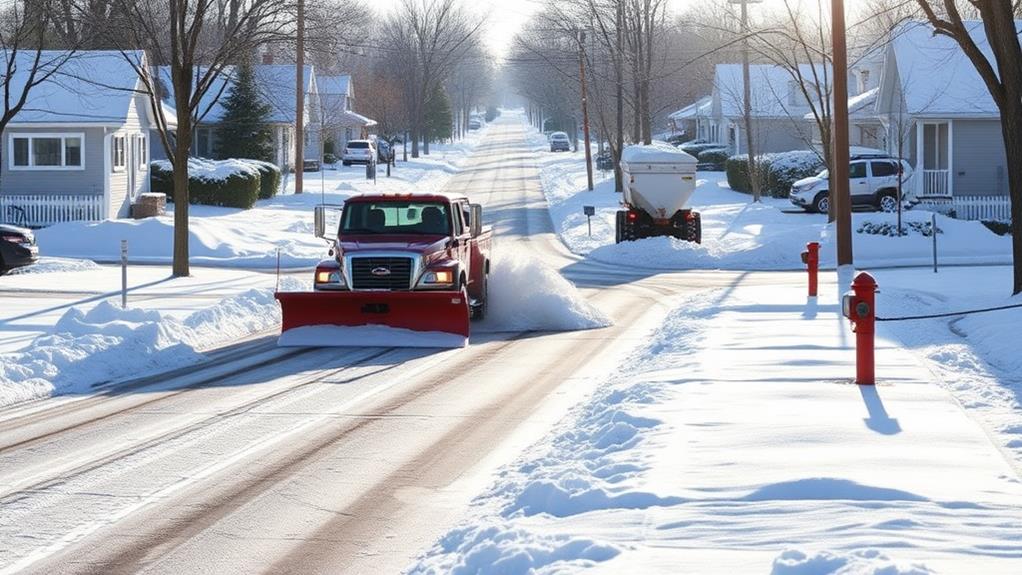
Snow removal regulations offer numerous benefits that extend beyond simply clearing sidewalks and roads. You'll find that these ordinances substantially improve safety for pedestrians by reducing slip-and-fall accidents, while also decreasing liability risks for property owners who comply with local snow removal requirements.
Additionally, prompt and thorough snow removal services guarantee that commercial property remains safe and accessible during snowstorms. Snow removal enhances the overall appearance of your community, certifying that emergency vehicles can access all areas quickly and efficiently during winter weather events.
Improved Safety for Pedestrians
While often overlooked, proper snow removal considerably enhances pedestrian safety during winter months. You'll notice a substantial reduction in slip-and-fall accidents when sidewalks, parking lots, and walkways are promptly cleared of snow and ice. This proactive approach guarantees that you and your fellow community members can navigate public spaces with greater confidence and security.
Effective snow removal regulations mandate the use of appropriate de-icing agents and snow-clearing equipment, which work in tandem to create safer walking surfaces. You'll find that well-maintained paths not only reduce the risk of injuries but also improve accessibility for those with mobility challenges. By enforcing timely snow removal, you're contributing to a more inclusive environment where everyone can move about freely, regardless of weather conditions.
Moreover, you'll appreciate how proper snow management enhances visibility for both pedestrians and drivers. Clear sightlines at intersections and crosswalks significantly decrease the likelihood of vehicle-pedestrian collisions, guaranteeing that you can safely cross streets and navigate your neighborhood. By adhering to snow removal regulations, you're actively participating in creating a safer winter environment for yourself and your community.
Reduced Liability for Property-Owners
Have you ever considered the legal risks associated with winter weather? As a property owner, you're responsible for maintaining safe conditions on your premises, which includes proper snow and ice removal. By adhering to snow removal regulations, you'll considerably reduce your liability and protect yourself from potential lawsuits.
When you comply with local ordinances and implement a thorough snow removal plan, you're demonstrating due diligence in safeguarding visitors and passersby. This proactive approach can serve as a strong defense if an accident were to occur. Many municipalities require property owners to clear sidewalks within a specific timeframe after snowfall, and failure to do so can result in fines or legal consequences. By staying on top of these requirements, you're not only avoiding penalties but also creating a safer environment for your community.
Furthermore, proper snow removal practices, such as using appropriate de-icing agents and maintaining clear pathways, can help prevent slip-and-fall accidents. This reduction in incidents translates to fewer potential claims against your property insurance, ultimately leading to lower premiums and long-term cost savings for you as a responsible property owner.
Enhanced Community Appearance
Beyond the safety and legal aspects, proper snow removal contributes greatly to the overall appearance of your community. When you and your neighbors diligently clear snow from sidewalks, driveways, and streets, you're creating a visually appealing environment that reflects pride in your neighborhood. This collective effort transforms snow-covered landscapes into well-maintained, accessible areas, enhancing the community's aesthetic appeal and fostering a sense of unity among residents.
Your commitment to timely snow removal helps maintain the charm and character of your neighborhood, even during harsh winter months. By keeping walkways and roadways clear, you're preserving the visual integrity of the community's architecture and landscaping. This attention to detail doesn't go unnoticed; it creates a positive impression on visitors and potential homebuyers, potentially increasing property values throughout the area.
Additionally, well-maintained winter streetscapes can boost community morale, encouraging outdoor activities and social interactions despite cold weather. When you participate in efficient snow removal, you're not just clearing paths; you're contributing to a more attractive, vibrant, and cohesive community that residents can take pride in year-round.
Efficient Emergency Vehicle Access
Proper snow removal plays a critical role in ensuring efficient emergency vehicle access. When you maintain clear streets and driveways, you're not just improving the aesthetics of your neighborhood; you're actively contributing to the safety and well-being of your community. Emergency responders, such as ambulances, fire trucks, and police vehicles, rely on unobstructed roadways to reach their destinations quickly. By adhering to snow removal regulations, you're helping to create a safer environment for everyone.
Consider the impact of snow-clogged streets on response times. Even a few minutes' delay can make a significant difference in emergency situations. That's why it's vital to use proper snow removal techniques, including plowing, salting, and sanding. These methods help maintain traction and visibility, allowing emergency vehicles to navigate safely and efficiently.
Additionally, by keeping fire hydrants clear of snow, you're ensuring that firefighters can access water supplies promptly when needed. Remember, your adherence to snow removal regulations isn't just about avoiding fines; it's about being a responsible community member who understands the importance of facilitating swift emergency response times in all weather conditions.
Snow Plowing Company Near you
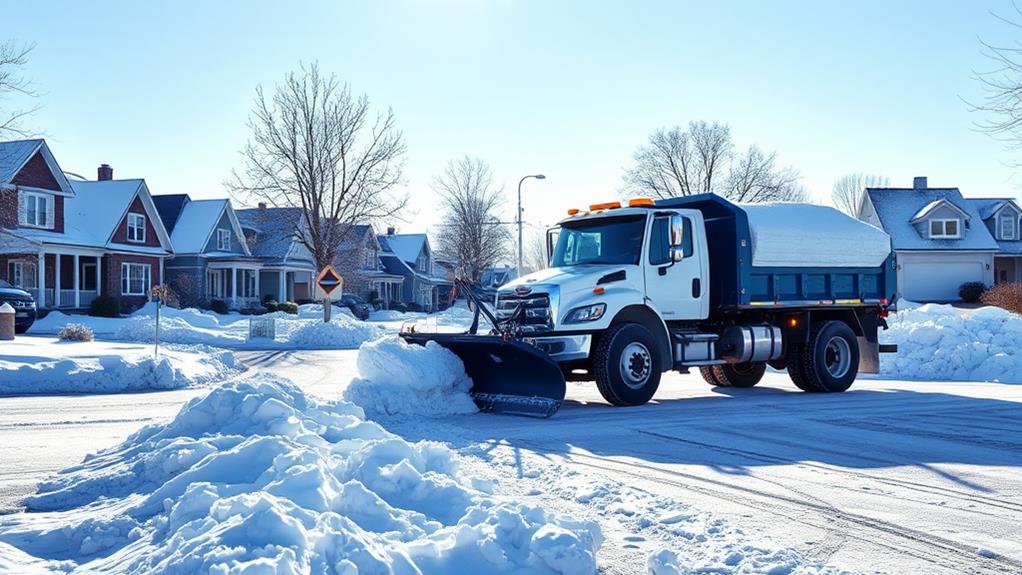
Snow Plow Solutions offers detailed commercial snow plowing and removal services to keep your business operations running smoothly during winter weather. Our experienced team, composed of passionate snow removal experts, uses state-of-the-art equipment to efficiently clear parking lots, driveways, and walkways, ensuring safe access for employees and customers.
We provide prompt, reliable service with flexible scheduling options to accommodate your business needs, whether you require regular maintenance or emergency snow removal. By partnering with Snow Plow Solutions, you can focus on your core business activities while we handle the challenges of winter weather, reducing liability risks and maintaining a professional appearance for your property.
Connect With A Team Member Today!
Don't let snow catch you off guard! Take control of your winter responsibilities today. Our expert team is ready to guide you through snow removal regulations and help you stay compliant.
We offer prompt response times and utilize heavy-duty equipment to provide efficient and thorough snow removal services. Call us now at (555) 123-4567 to guarantee a safe and hassle-free winter season. Act fast – your peace of mind is just a phone call away!
Alternate Snow Removal Methods
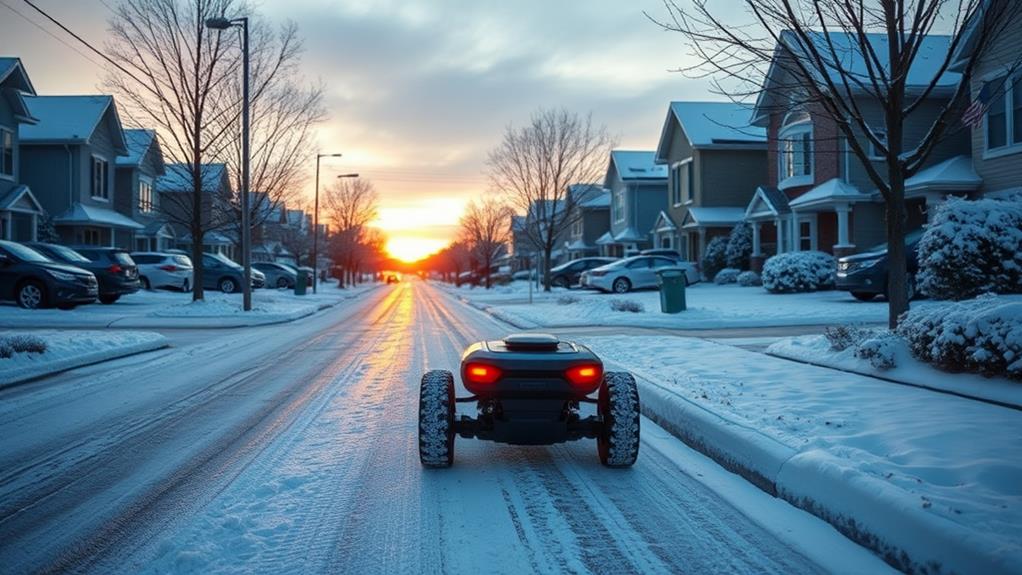
When considering alternate snow removal methods, you'll find a range of options that go beyond traditional shoveling and plowing. You might explore eco-friendly snow melting techniques that use biodegradable materials or heated driveway systems that prevent snow accumulation altogether. For those who prefer a hands-on approach, you'll want to weigh the pros and cons of snow blowing versus shoveling, considering factors such as efficiency, physical exertion, and equipment costs.
| Method | Pros | Cons |
|---|---|---|
| Eco-Friendly Melting | Environmentally safe, low impact | Can be slower, more expensive |
| Heated Driveways | Automatic, no manual labor | High installation and operating costs |
| Snow Blowing | Faster than shoveling, less physical strain | Requires equipment purchase, maintenance |
| Shoveling | No equipment needed, good exercise | Time-consuming, physically demanding |
Eco-Friendly Snow Melting Techniques
As environmental concerns grow, many communities are exploring eco-friendly alternatives to traditional snow removal methods. You'll find that these techniques not only reduce the environmental impact but also offer long-term cost savings and improved safety for your community.
One popular option you might consider is the use of heated pavement systems, which utilize electric heating elements or geothermal energy to keep surfaces snow-free. These systems can be installed beneath sidewalks, driveways, and parking lots, eliminating the need for salt and mechanical removal.
Another eco-friendly approach you can adopt is the use of organic deicers, such as beet juice or cheese brine. These natural alternatives are less corrosive than traditional rock salt and don't harm vegetation or water sources. You'll also want to explore the benefits of snow-melting mats, which use electricity to melt snow and ice on contact. These portable mats can be placed strategically in high-traffic areas, reducing the need for chemical deicers.
Heated Driveway Systems
Heated driveway systems offer a revolutionary approach to snow removal, eliminating the need for manual shoveling or plowing. These systems utilize embedded heating elements, typically electric cables or hydronic tubing, beneath your driveway's surface to melt snow and ice as they accumulate. You'll find that this technology not only saves time and effort but also enhances safety by preventing dangerous ice buildup.
When you invest in a heated driveway system, you're joining a community of homeowners who prioritize efficiency and convenience. The system operates automatically, activating when temperatures drop below a preset threshold, ensuring your driveway remains clear throughout winter storms. While the initial installation cost may be significant, you'll appreciate the long-term benefits, including reduced liability risks and decreased wear on your driveway's surface.
Heated driveways are particularly advantageous for properties with steep inclines or areas prone to heavy snowfall. You'll notice improved traction and accessibility, even during the most severe winter weather. Additionally, these systems can be zoned to target specific areas, allowing you to customize coverage based on your property's unique needs and maximize energy efficiency.
Snow Blowing vs. Shoveling
For those without heated driveways, the age-old debate between snow blowing and shoveling continues. When evaluating your snow removal options, you'll need to weigh factors such as property size, snow accumulation, and personal physical capabilities.
Snow blowers offer efficiency and speed, particularly for larger areas or heavy snowfall, while shoveling provides a more precise and cost-effective solution for smaller spaces or light snow.
To help you make an informed decision, examine these key points:
- Snow blowers can clear large areas quickly but require maintenance and storage
- Shoveling offers a low-cost, environmentally friendly option with built-in exercise benefits
- Electric snow blowers provide a quieter, emission-free alternative to gas-powered models
When choosing between snow blowing and shoveling, you'll want to assess your specific needs and resources. Snow blowers, while more expensive upfront, can save time and reduce physical strain during heavy snowfalls. They're particularly effective for clearing driveways, sidewalks, and large pathways.
Shoveling, on the other hand, allows for greater precision in tight spaces and can be more suitable for light, powdery snow. It's important to consider your physical fitness and any health concerns when deciding between these methods.
Frequently Asked Questions
How Soon After Snowfall Are Property Owners Required to Clear Sidewalks?
You'll want to clear your sidewalks promptly after snowfall. Most cities require property owners to remove snow within 24 hours. It's a great way to show you care about your neighbors and community. Don't forget to check local regulations!
Are There Exemptions for Elderly or Disabled Residents Regarding Snow Removal?
You'll find that many cities offer exemptions for elderly or disabled residents. Check with your local government to see if you qualify. Your community understands and wants to support you during challenging winter weather.
What Are the Penalties for Not Complying With Snow Removal Ordinances?
You'll want to be careful about snow removal compliance. Penalties can include fines, which may increase for repeat offenses. In some cases, you might face legal action. It's best to stay on top of your community's requirements.
Can I Be Held Liable if Someone Slips on Ice on My Property?
You can be held liable if someone slips on ice on your property. It's important to keep your walkways clear for everyone's safety. By taking care of this, you're looking out for your neighbors and community.
Are There Regulations for Disposing of Snow Removed From Private Property?
You'll want to check your local ordinances for snow disposal rules. Many areas have specific guidelines to keep our community safe and clean. Don't dump snow on streets or sidewalks—it's often illegal and can inconvenience your neighbors.
